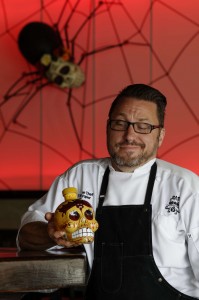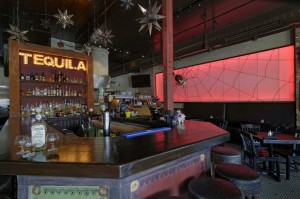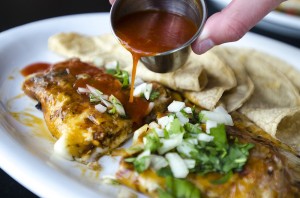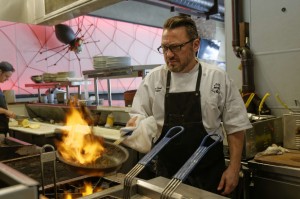
Executive Chef Richard Papier opened Arana in New Orleans’ Garden District about a year ago. He is holding a bottle of Kai tequila (Day of the Dead), one of their many varieties. (Photo © Kent Hardouin)
By Laurie Wiegler
Over 1,800 people died as a result of Hurricane Katrina. Many more fled the city prior to the floods, including Richard Papier. Ten years later, he finally came back.
“I didn’t know if my home was OK. I was sitting at a computer watching the governor on TV talking about the city,” recalls Richard Papier of New Orleans. Although his home was in the Garden District, far from the Lower 9th Ward, he didn’t realize it had been spared from the floods.
Papier had had to flee, along with thousands of others, days before Hurricane Katrina slammed into Southeastern Louisiana in late August 2005. He left for North Carolina, but not as quickly as he planned. Traffic was snarled. Power lines were down.
“Trying to get out of town was crazy. We had to drive to Baton Rouge just to get out of town… Both sides of the interstate were being used, yet even so, what usually took 45 minutes to an hour took about five hours. We couldn’t find a gas station, either.”
Back to New Orleans
But while it’s clear why a chef would flee New Orleans pre-Katrina, it’s less clear why he’d return.
Yet, like most New Orleanians, there’s really no place like home. Anyone who’s spent time in the Big Easy – beyond the commercialized uber-publicized bead-strewn bacchanalia that is Bourbon Street – knows it’s as warm as its gulf breezes, as uplifting as a Hurricane cocktail at Pat O’Brien’s.
Born and raised just outside NOLA, Papier spent his youth coming into the city to buy records or CDs, and frequent cafes and bars. Seeing his hometown clobbered by Mother Nature and the subsequent collapse of the levees just reinforced his resolve to return to the home he loves.
Anyone who’s spent time in the Big Easy – beyond the commercialized uber-publicized bead-strewn bacchanalia that is Bourbon Street – knows it’s as warm as its gulf breezes, as uplifting as a Hurricane cocktail at Pat O’Brien’s.
For here, he had gotten his start working for some of the city’s top chefs such as Emeril Lagasse, Susan Spicer, and Neal Swidler. Yet, it was his tutelage under the chef he considers a mentor, Guillermo Peters from Mexico City, that ingrained his passion for Yucatan-style cooking.
So now, three years after leaving New Orleans, he’d return. But to what?
An Idea Germinates
The young chef – he was in his thirties at the time – didn’t immediately figure on helping to open a restaurant. Rather, he knocked around in various jobs including food styling for the film industry – specifically, staging food for films like the Thanksgiving scene in “The Butler.”
“Say, everyone’s around this perfectly cooked turkey. But it’s the middle of March and they need a giant 23-pound turkey! [At the most] Walmart would probably have a 21-pounder.”
So he says he went out and bought it, but had to shellac it while frozen and cover it in wood varnish and paint on black spots to effect the perfect Norman Rockwellian look the film required. He also worked on “21 Jump Street” with Channing Tatum and Jonah hill, a Stallone-DeNiro comedy, and others.
“If you are a celebrity, people – other than the tourists – won’t bother you here,” Papier says.
Yet as glamorous as all this sounds, it wasn’t quite a fit for his true passion: creating a fabulous Yucatan restaurant in his beloved Garden District.
For those unfamiliar with the city, this is where celebs like Anne Rice, Sandra Bullock and the Archie Manning family have their gorgeous historic homes, many of them mansions, near the St. Charles street car line.
Open for Business
A Mexican restaurant in New Orleans, though? Papier acknowledges that it’s not the first type of cuisine one thinks of in this wash of jambalaya, crawfish and beignets. But the city’s history includes a strong connection to the early Spanish settlers, as well as the French, and it’s just a small leap from tapas to paella.

The bar is a draw for clientele at the taqueria, who can join a special “society” or just try a bevvy of tequilas. (Photo © Kent Hardouin)
So he took the plunge, and a year ago helped open Araña Taqueria y Cantina in the Garden District. Popular dishes include what Papier calls “one of the better Chicken Moles in town.” Also, they make something called a “Queso Fundido” which he explains is sort of a twist on uh, Velveeta in a shell?
“But instead of being liquefied with Velveeta we use Oaxaca cheese and put it on the flat top so it gets doubly crispy and brown, like a burrito shell with cheese,” he says. Then he adds chorizo, and completes this magical “street food.”

A closeup of the Queso Fundido with chorizo that’s been whipped up by Executive Chef Richard Papier. (Photo © Katie Sikora Photography)
“We’re definitely doing Mexican street food,” Papier says. “We’ll also do some fan favorites. People come here know Mexican food from Mexican restaurants, so we’ve started doing fajitas, for example.”
The menu is rounded out with muy delicioso “Baja Fish,” “Yucatan Nachos,” “Pibil” (pulled pork, pickled onion), and mucho, mucho mas. It’s all dizzyingly delicious – and decidedly different.
For the allure of Araña far surpasses the draw of Tex Mex joints peppering the Gulf. Besides food specialties, their standout is a tequila bar that even includes a “society” replete with one’s own “passport” to try one of their dozens of tequilas.
“I think that food is like fashion, it changes very often,” he says. “People are tired of doing the big fine dining [thing] and big show for food, so they like to go someplace small and intimate and try something they’ve never had before.”
The response to the taqueria? It’s been muy bueno!
“We don’t have a huge Mexican community here in New Orleans – ours is mainly Honduran. People who know what real Mexican food is, not Tex Mex, are really happy to see it,” says Papier. “It’s definitely a chef-inspired restaurant, but not at high prices.”

Leave a Reply